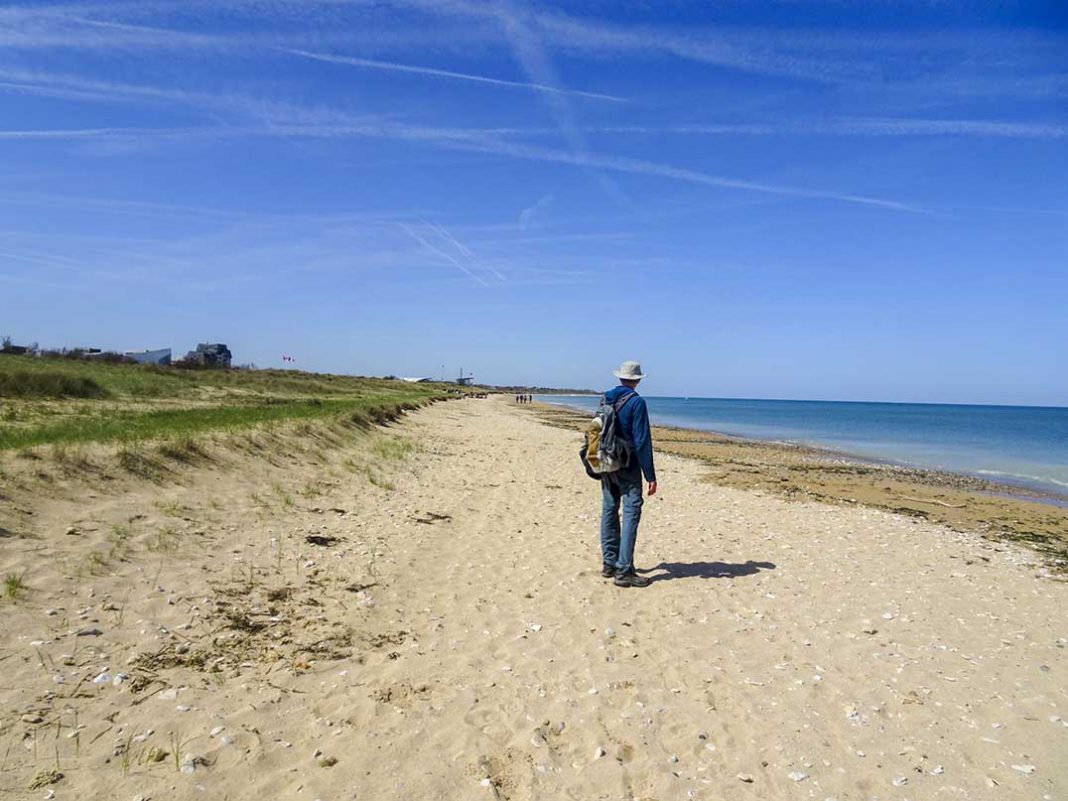TEHKUMMAH—We all have those things that we hope to accomplish before we shuffle off this mortal coil, our bucket list. For Big Lake’s John Diebolt that list included a very special pilgrimage to the battlefields of Europe.
“One of my bucket list dreams was to follow in my dad’s footsteps across Europe as he served with the Scottish Essex,” said Mr. Diebolt. “I was very fortunate as my friend Wayne Neal (a summer resident of Mindemoya) came across the war diary of the Scottish Essex in his research.” Mr. Neal is a student of military history and the author of a number of books and articles on the subject.
“Wayne is a good friend of ours and his father-in-law was the late Charlie Cadieux,” said Mr. Diebolt. “Wayne is very knowledgeable about the Second World War.”
The Scottish Essex Regiment was founded in 1885, then known as the 21st Essex Battalion of Infantry, the military unit went through several name changes including the 21st Battalion, Essex Fusiliers, the 21st Regiment Essex Fusiliers and the Essex Fusiliers, finally finding the title the regiment would bear until its disbandment in 1954.
During World War II the Scottish Essex Regiment was among the first Canadian units to see combat in the European theatre, taking part in the invasion of Dieppe. By the end of the Dieppe Raid, the Essex Scottish Regiment had suffered 121 fatal casualties, with many more wounded and captured. The Essex Scottish later participated in Operation Atlantic where it took severe casualties attempting to take the Verrières Ridge on July 21. By the war’s end, the Essex Scottish Regiment had suffered over 550 war dead and its 2,500 casualties were the highest of any unit in the Canadian army during the Second World War. Today the Scottish Essex and its battle honours have been amalgamated into the Essex Kent Regiment.
The two friends had talked about making the journey with a group of like-minded friends, but over the course of time several dropped out. “Wayne and I looked at each other and just decided to go,” he laughed.
So began a journey that would prove to be an adventure containing an unexpected roller coaster of emotions for both of the friends. Each had their own reasons for undertaking the pilgrimage. Mr. Diebolt to better understand some of the most formative years of his father’s youth and Mr. Neal wanted to seek out the places where the poet who wrote ‘In Flanders Fields’ had served and died.
For Mr. Diebolt, the journey would take him from the sands of Juno Beach, where his father had landed with the Scottish Essex Regiment, the community of Dieppe, and countless small battlefields amongst the hedgerows of Belgium, Holland and France.
Mr. Diebolt recalled the experience of walking along the sands of Juno Beach. “It was a very typical big beautiful sand beach,” he said. But as he walked along those grains of sand after having visited the nearby war museum, Mr. Diebolt could sense the eyes of those young Canadian soldiers who stormed ashore looking over his shoulder.
Later, he and Mr. Neal would be walking among the gravestones of small immaculate cemeteries that stand close by to where the soldiers who fell in battle were interred. Mr. Diebolt was struck by what he saw engraved on many of those markers.
“A lot of people talk about young men going to war,” said Mr. Diebolt. “But a lot of the soldiers buried here were in their 30s and even 40s.” These would have been men, many of whom had families and children of their own back home who would have received a dreaded telegram or found their parent’s name listed in the count of the dead or missing.
“We met a lot of really welcoming people wherever we went,” recalled Mr. Diebolt. “As soon as they learned that you were Canadian they just couldn’t do enough for you.”
He and Mr. Neal met one woman, Therese Founeau, who was a young girl of 10 when the Canadian Army came through the area near the village of St. Lambert sur Glise where she lived. Now around 91 or so, Ms. Founeau recalled the day a Canadian tank commander who was headed towards a nearby battle that came to be known as the Falaise Gap saluted her from the top of his tank and tossed her a chocolate bar.
“We stayed at a lot of little bed and breakfasts in small villages,” said Mr. Diebolt. It was an opportunity to get to know a lot of people who lived their lives close to where the actual war took place. “We ate with them at their tables and learned a lot about the communities where they lived.”
Mr. Diebolt’s father never talked much about his war experiences. Most of those who served in combat share that characteristic. “Growing up, my dad never talked about what happened over there,” he said. “There was just the odd thing he would mention now and then.” But in the last five or six years of his life he began to talk, recording on tape a number of his experiences.
One very striking reminiscence spoke volumes of the horror that he experienced as a member of one of Canada’s most storied and devastated combat units. “He talked about walking across a field and the guy walking on one side of him fell, then the guy on the other side dropped, and he had to keep on going,” he said. “He never saw them again, he never knew what happened to them, if they had died or were wounded and survived the war. That’s how it was in those days.”
The trail of his father’s footsteps largely amounted to visiting a series of cemeteries.
“They tended to bury the dead close to where the battle took place,” said Mr. Diebolt. “So there are all these small graveyards that follow where the Scottish Essex fought.”
He recalled one very touching living monument during a visit to a battle site in Holland, coming across a solitary maple tree bearing a small plaque. “The people there had planted a maple and put a small plaque on it to remember those who fell there,” he said. “We saw school children who go as part of their school work to visit the graves and learn about the history. I can’t say enough about how well kept the Commonwealth War Graves keep the graves.”
Mr. Neal also had a personal connection to the areas the duo visited. Having researched the lives and actions of Canadian Victoria Cross winners, especially Lt. Colonel David Henry Currie, who was awarded the Victoria Cross for his actions in command of a battle group of tanks from The South Alberta Regiment, artillery, and infantry of the Argyll and Sutherland Highlanders of Canada at St. Lambert-sur-Dives in France, during the final actions to close the Falaise Gap. His was the only Victoria Cross awarded to a Canadian soldier during the Normandy campaign (June 6, 1944 through to the end of August 1944) and the only VC ever awarded to a member of the Royal Canadian Armoured Corps.
The then 32-year-old Major Currie was in The South Alberta Regiment during the Battle of Falaise between August 18–20, 1944. In command of a small mixed force of tanks, self-propelled anti-tank guns and infantry, they had been ordered to cut off one of the Germans’ main escape routes.
After he led the attack on the village of St. Lambert-sur-Dives and consolidated a position halfway inside it, his force repulsed repeated enemy attacks over the next day-and-a-half. Despite heavy casualties, Major Currie’s small force destroyed seven enemy tanks, twelve 88 mm guns and 40 vehicles, which led to the deaths of 300 German soldiers, 500 wounded, and 2,100 captured. As a result, the remnants of two German armies were denied an escape route.
“My interest was Sergeant Jack Stollery,” said Mr. Neal. Mr. Stollery was a reporter at a St. Thomas paper, where Mr. Neal hangs his hat when not on Manitoulin. Mr. Stollery, as a war photographer, actually took the famous photograph of Maj. Currie winning his Victory Cross.
“I knew Jack Stollery,” said Mr. Neal. “He died very young, before he was 60 I think, but it was quite a heroic career he had. I knew Jack through the Rotary Club. He was very outgoing.”
As to what induced his father to enlist, Mr. Diebolt noted that, like a lot of young men of the time it wasn’t so much King and Country, although that was very much the spirit of the times, as it was an opportunity to escape the mundane. “My dad said he signed up because ‘I was bored’,” recalled Mr. Diebolt.
But after serving in a combat unit, the elder Mr. Diebolt definitely came back a changed man.
“He never talked about it, and as kids we knew not to ask.” Despite coming from a very definite hunting tradition, the younger Mr. Diebolt recalled that “he never fired a rifle again when he came back.”
But Mr. Diebolt recalls his father as a very even tempered and calm person.




